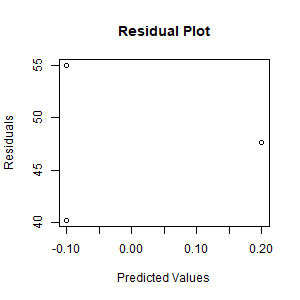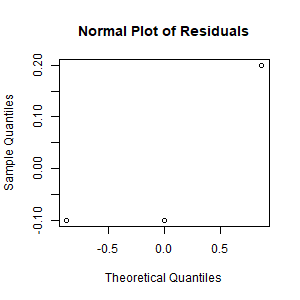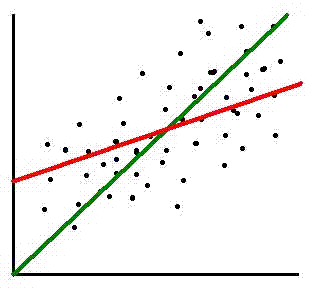| Obs: | 1 | 2 | 3 |
| Year: | 2003 | 2006 | 2009 |
| Spending: | 40.1 | 47.8 | 54.9 |
Spending is in billions of dollars. These data values are slightly different than the values used in class on May 8. Answer these questions:
- Create a scatterplot of Spending vs. Year. Answer:
> year <- c(2003, 2006, 2009) > spending <- c(40.1, 47.8, 54.9) > plot(year, spending, xlab="Year", ylab="Spending")

- Use R to obtain x, y,
SD+x, SD+y, and rxy Answer:
> year [1] 2003 2006 2009 > spending [1] 40.1 47.8 54.9 > mean(year) [1] 2006 > mean(spending) [1] 47.6 > sd(year) [1] 3 > sd(spending) [1] 7.402027 > cor(year, spending) [1] 0.9997262
- Obtain the regression equation by hand using the statistics from Question 2b.
When performing hand calculations, you can use R as a calculator.
Verify your answer with the R lm function. Answer:
The regression equation is
y - y = (r * SD+y / SD+x)(x - x)
y - 47.6 = (0.9997262 * 7.402027 / 3)(x - 2006)
y - 47.6 = 2.466667 * (x - 2006)
y = 2.466667 x - 2.466667 * 2006 + 47.6
y = 2.466667 x - 4900.534
To compute the regression equation using R, we first need to create a data frame containing the data. Then we use the lm function to obtain the regression model:
> df <- data.frame(x=year, y=spending) > model <- lm(y ~ x, data=df) > print(model) Call: lm(formula = y ~ x, data = df) Coefficients: (Intercept) x -4900.533 2.467
- Compute the predicted values by hand. Check your
answer using this R function call:
> pred <- predict(model)
Use the model obtained in Exercise 2c:
y^1 = 2.467 * x1 - 4900.533 = 2.466667 * 2003 - 4900.534 = 40.2
y^2 = 2.467 * x2 - 4900.533 = 2.466667 * 2006 - 4900.534 = 47.6
y^3 = 2.467 * x3 - 4900.533 = 2.466667 * 2009 - 4900.534 = 55
We can perform this calculation in one line using R:
> 2.466667 * c(2003, 2006, 2009) - 4900.534 [1] 40.2 47.6 55.0
Check your answer using the R predict function, which obtains the predicted values from the model:
> p <- predict(model) 1 2 3 40.2 47.6 55.0
- Compute the residuals, which are computed as
e^i = yi - y^i
e^1 = y1 - y^1 = 40.1 - 40.2 = -0.1
e^2 = y2 - y^1 = 47.8 - 47.6 = 0.2
e^3 = y3 - y^1 = 54.9 - 55.0 = -0.1
Check your answer using the R resid function, which computes the residuals from the model. Answer:
> resid(model) 1 2 3 -0.1 0.2 -0.1
- Create the residual plot of residuals vs. predicted values. Answer:
> plot(resid(model), predict(model), + xlab="Predicted Values", ylab="Residuals", + main="Residual Plot")

- Compute the normal scores by hand (n=3).
Answer: the normal scores when n=3 divid the standard normal density into 4 equal areas or 25% each. The z-scores that do this are found at -0.67, 0.00, and 0.67. These can be found using the R qnorm function like this:
> qnorm(c(0.25, 0.5, 0.75)) [1] -0.6744898 0.0000000 0.6744898
- Create and normal plot for the residuals. Answer:
> qqnorm(resid(model), main="Normal Plot of Residuals")

Answer: recall the ideal measurement model: xi = μ + ei (actual measurement = true value + random error. μ is usually unknown and estimated by μ^= x.
The true regression equation is yi = a * xi + b, where the slope a and the intercept b are unknown and must be estimated by a^ and b^, which are determined from the estimated regression equation:
y - y = (r^ * SD+y / SD+x)(x - x)
which is rewritten as
y = a^ * x + b^.
